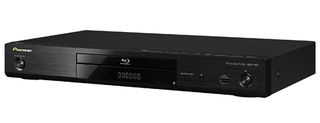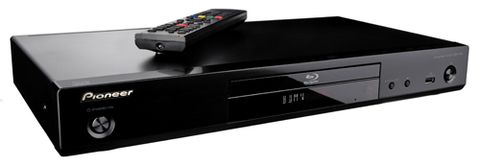Some manufacturers go for flashy styling. Others offer fancy tricks.
Pioneer has a different approach with the BDP-160; a budget Blu-ray player that’s more concerned with performance.

Picture
And what a performance it is! We’re very impressed with the picture, which is bold and punchy. We start off with a Blu-ray of Pacific Rim and contrast is strong, with vibrant but nicely balanced colours.
It’s a detailed picture too: it’s easy to make out the battle damage on buildings and armour.
The Sony BDP-S4100 may be a touch more nuanced with finer details and subtle shading, but there’s not much in it. This is a class-leading picture.
We switch to a DVD of Return Of The King and the Pioneer shows itself to be a good upscaler.
There’s an inevitable drop in sharpness and clarity, but the picture is like it was with Blu-ray: punchy, with good colours and plenty of detail.
Sound quality

We’re pleased to say the sound is as impressive as the picture. Crucially, it’s tonally even: the BDP-160 takes as much care with dialogue as it does with robots punching monsters in the face. There’s also a good sense of texture.
Next we play a Blu-ray of Beyoncé in concert, and the sound is wide, and atmospheric.
The Sony’s lean sound gives it greater agility and excitement, but the Pioneer counters with a fuller, weightier presentation, which brings more power to the table. Again, it’s a close call that comes down to personal taste.
Time for a CD, and we put in Eminem’s Marshall Mathers LP2. Our findings are consistent: the sound is balanced, detailed, and comfortably weighty.
Design and build

The BDP-160 has now matched an Award-winner on picture and sound, so it seems that focusing on performance has paid off for Pioneer.
But that doesn’t mean the machine is lacking elsewhere.
This doesn’t look or feel like a budget machine. Blu-ray players seem to be getting fancier or more plasticky – the Sony BDP-S4100 is both – and we welcome something that looks like a piece of classy, traditional AV kit.
There’s a lot of brushed metal, which adds up to just less than 3kg. It’s put together well, and feels very sturdy. Admittedly, you probably won’t move your Blu-ray player around on a regular basis, but it’s good to know it could probably take a few knocks.
In terms of perceived value, the Pioneer is much more appealing than many players at this price.
Connectivity and features

There’s a decent set of connections. You get one each of HDMI, digital coaxial and two-channel analogue outputs. There are also two USB ports, in case you want to play something from a memory stick.
A LAN socket and built-in wi-fi give you access to internet-based fun, by which we mean YouTube and Picasa.
That’s all you get, and there’s no hub or app market for downloading more, although there are network-based features such as DLNA (stream from a networked computer) or wi-fi direct (copy your smartphone’s image on screen).
We wouldn’t expect much more for the money.
We’d want pricier Blu-ray players to have more bells and whistles, but at this price these features are more of a helpful bonus than an attempt to rival the smart experience on a high-end TV.
Operation

The Pioneer takes about 10 seconds to wake up. Discs inserted will load automatically, and it’s only a few seconds before you’re taken to the content.
The disc tray rattles slightly when sliding out, but the player is pretty quiet otherwise.
The remote control is nicely laid out and clearly labelled. We quite like the red button near the centre, which is a direct line to YouTube.
If you want something a little fancier, there’s the Pioneer iControlAV2013 smartphone app for Android and iOS. The physical remote is fine, though.
Press stop (or don’t insert a disc) and the remote’s ‘home’ button takes you to a very basic interface that gives you three options: content, web content and settings.
It’s a sparse, purely functional menu that almost feels like the back end of the machine. It’s fairly responsive but take one look and it’s clear that Pioneer really wants you to stick to spinning discs.
Speaking of which, the BDP-160 can handle SACDs as well as DVDs and Blu-rays. SACDs show the usual uplift in performance over CDs, but we’d still use a dedicated music player if stereo music replay is a priority.
Verdict
The Pioneer BDP-160 has shown that you don’t need shiny looks or snazzy features to be really good.
This entry-level unit may be a simple affair, but where it counts, it’s up with the best at this price.
It’s no all-in-one media box, but if you’re after a no-frills Blu-ray player, you need to give this a go.

